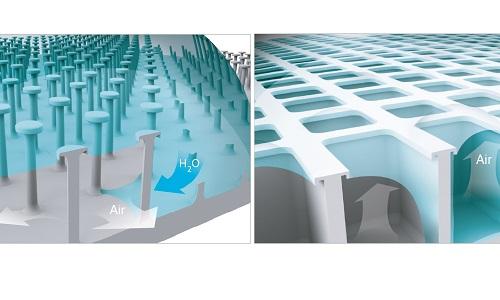
Credit: Reproduced with permission from ref 1.© 2017 American Chemical Society
Inspired by nature, an inexpensive green technique that enables common materials to repel liquid has been developed by KAUST scientists and could lead to diverse applications from underwater drag reduction to antifouling.
Making surfaces liquid repellent, referred to as omniphobicity, is used in a range of industrial processes from reducing biofouling and underwater drag to membrane distillation, waterproofing and oil-water separation.
Producing such a veneer generally relies on applying perfluorinated coatings; however, these degrade under harsh physical and chemical environments, increasing costs and both health and environmental impacts and limiting their use.
Rendering conventional materials, such as plastics and metals, omniphobic has been a tantalizing goal for some time; this challenge led Himanshu Mishra and colleagues from the KAUST Water Desalination and Reuse Center to seek inspiration from nature.
The researchers first tested microtextures comprising doubly reentrant pillars: they were inspired by a US-based research team who, in 2014, demonstrated these pillars exhibited unprecedented omniphobicity in air, even when the materials were intrinsically wetting.
"At first, these results seemed to defy conventional wisdom as roughening intrinsically wetting surfaces makes them even more wetting," said Mishra. "So we decided to investigate these microtextures for ourselves."
The team confirmed that intrinsically wetting surfaces with doubly reentrant micropillars do indeed exhibit omniphobicity in air, but they also found that it was catastrophically lost in the presence of localized physical defects or damage or upon immersion in wetting liquids.
"These were serious limitations because real surfaces get damaged during use," said Mishra. "This inspired us to look to nature and investigate the skins of springtails."
Patterns on the skin of springtails–tiny soil-dwelling insects that live in moist conditions–exploit surface textures that contain doubly reentrant cavities, keeping them dry. By using photolithography and dry-etching tools at the KAUST Nanofabrication Core Lab, the researchers recreated these doubly reentrant microcavities on silica surfaces.
Taking advantage of the doubly reentrant features showed that the microcavities trapped air and prevented penetration of liquids, even under elevated pressures. In addition, their compartmentalized nature prevented any loss of omniphobicity in the presence of localized damage or defects or upon immersion in wetting liquids.
"Having demonstrated the proof of concept, we now plan to translate the fabrication process from the lab to the Workshop Core Lab in KAUST to create doubly reentrant cavities on common materials, such as polyethylene terephthalate and low-carbon steels," said Mishra. "This may help to unlock their potential for applications to reduce hydrodynamic drag and antifouling."
###
Media Contact
Michelle D'Antoni
[email protected]
http://kaust.edu.sa/
Original Source
https://discovery.kaust.edu.sa/en/article/385/nature-provides-a-key-to-repelling-liquids http://dx.doi.org/10.1021/acsami.7b03526





